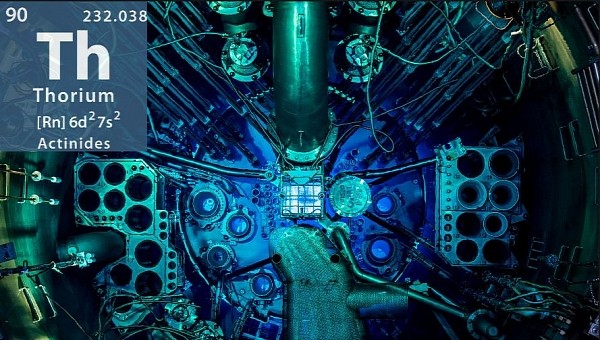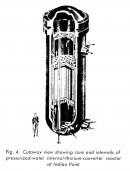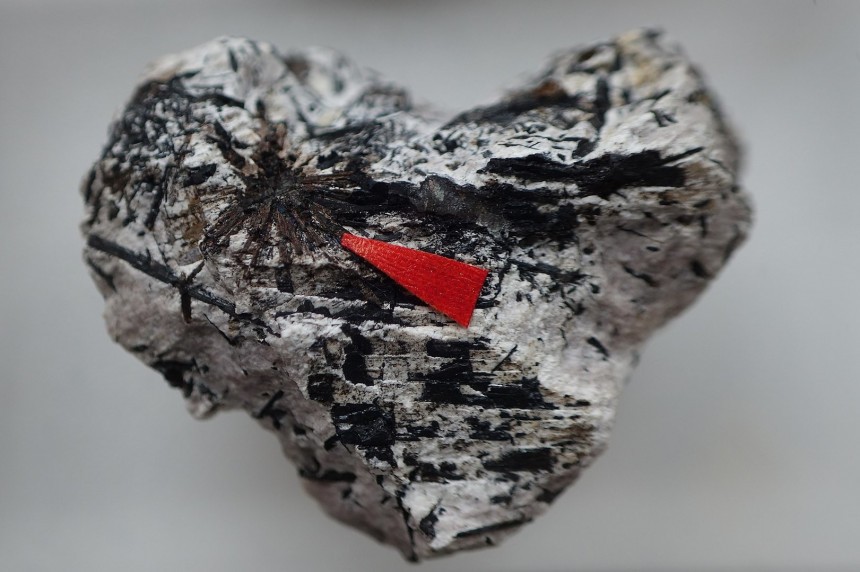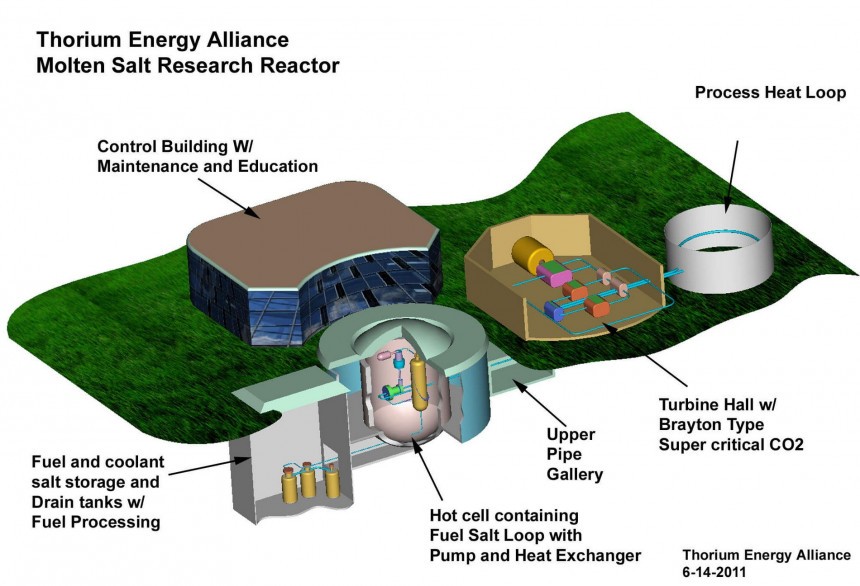We took a look at the element tritium a short time ago. A "high octane" and ultra-rare nuclear isotope of which we have a global supply you could fit in an XL-sized suitcase. A supply that small could only power the average fusion reactor for around a couple of months. That puts modern technology in the midst of a perplexing little problem. But the answer isn't throwing in the towel and submitting to the petrostate.
But don't despair. Because while it's pretty darn hard to get our hands on any more tritium, or even sustainable nuclear fusion for that matter, there are always other options. Back in the hum-drum world of nuclear fission, with its popular image full of meltdowns, radiation poisoning, and general misery, a better solution is better fissile fuel. The fuel in question might be atomic number 90 on the periodic table, thorium.
Only a handful of places on Earth harbor substantial enough uranium deposits to justify multi-billion-dollar mining operations. According to the non-profit World Nuclear Association, three countries, Namibia, Uzbekistan, and Canada, mine well north of half the entire world's uranium ore. In general, naturally occurring uranium-235 and 238 are the most associated with fission reactors. It doesn't take a brainiac to figure mining the stuff deep beneath the surface of the Earth poses some health hazards.
In a worst-case scenario, unproperly regulated uranium mining causes just as much harm to the human body over an extended period as a few minutes exposed to the first effects of Chornobyl (Chernobyl). Add in shakey ventilation in some cases, and your start to realize mining uranium might be best left to robots one day. Once you have enough uranium ore to process into fuel, you must separate it from the surrounding rock and process it into more enriched nuclear fuel rods.
In places around the world where more readily available non-uranium fissile fuel is vital, the benefits of thorium should speak for themselves. With this in mind, thorium has the potential to revolutionize the industry without having to change too much about the core operations of existing nuclear reactors. If that wasn't enough, the monazite mineral from which thorium is commonly sourced has higher concentrations of material than the equivalent uranium ore.
Thorium ore is prevalent in a wide array of places around the world, including the United States. That's certainly not a trait uranium can claim. Not just a handful of places that may or may not be willing to share their supplies. By itself, thorium acts much the same as iron, hydrogen, helium, or really any naturally occurring, non-fissile element. The biggest difference between thorium and common, everyday elements is that it's what's known as a fertile nuclear element.
In simple terms, it's only when energized sub-atomic neutrons bombard atoms of thorium that it can be transmuted into a uranium-233 isotope. As if by pure alchemy, it's actually rooted in scientific fact. After a bit of post-processing, this uranium is ready to be mixed with a neutron-moderator material, often graphite, formed into fuel rods, then placed inside reactor cores. No setup of mines deep beneath the surface of Kazakhstan is required. This should be nothing short of revolutionary.
Known as the thorium fuel cycle, this process was once earmarked for far more intensive studies than what eventually transpired. The world's first practical thorium-derived fission reactor was constructed at the Indian Point Energy Center in Westchester County, New York State, in 1962. Since then, an international consortium of bigwigs like the Kurchatov Institute in Russia and the Brookhaven National Laboratory in Long Island, New York, have attempted to market the thorium fuel cycle globally.
Only the Oak Ridge National Laboratory in Tennessee has ever played host to this peculiar and spooky-sounding molten salt reactor (MSR). Doing so on two separate occasions, no less. But, if the Chinese have a say in the matter, their TMSR-LF1 thorium MSR, due to come online any day, would be the first of its kind deployed to operation outside U.S. soil.
Because MSRs operate using a nuclear-fuel mixture already in the molten state, the chances of a high-pressure steam explosion, like what happened at Chornobyl, should be close to zero. Granted, uranium-233 forged from thorium tends to decay into more radioactive forms somewhat faster than other isotopes. But with modern regulations regarding nuclear waste products, it's no worse for human exposure than typically enriched uranium.
Should the powers that be see it fit, many of the world's most powerful reactors could be modified, albeit at great cost, to accommodate fissile fuel made from atomically fertile thorium. With this in mind, the notion that humanity need not bore deep into very specific areas to fulfill its need for fissile fuel is one you should be surprised isn't more widespread. Well, perhaps thorium's more docile, controllable nature worked against its favor during the hotter parts of the Cold War.
Nearly 70 years later, the full uses of the thorium fuel cycle are still nowhere near close to being fully exploited. That said, countries with next to no domestic supplies of uranium of their own, like India and China, might soon be ready to grab the brass ring for the first time. If successful, expect global superpowers in the west and the Far East to follow suit with their own novel reactors using the thorium fuel cycle. Though it's yet to be proven in practice, some scientists claim thorium could be even more useful in solving the global energy crisis than even novel forms of nuclear fusion. At least in the short term, that is.
If you ask us, thorium has the potential to be one of the most important puzzle pieces to solving the global emissions crisis. In terms most petrol heads can understand, it's best to think of enriched uranium as the expensive 93-octane pump gas. With lots of latent energy stored inside and potentially a higher efficiency, but not always readily available. On the other hand, thorium is your plain-Jane 87-octane. Not all that exciting on the face of it, but it's always going to be around.
Check back soon for more nuclear energy news coverage here on autoevolution.
Uranium's Considerably Less Spicy Cousin
But to understand why thorium was, at one point, a very valuable element and could one day be again, we need to understand the problem with certain types of fission fuels. Any number of different radioactive isotopes could realistically power a nuclear fission reactor. But, for the sake of simplicity, let's focus on uranium specifically. If you think lithium and cobalt mining for EV batteries is a pain in the you-know-what, uranium might have it beaten.Only a handful of places on Earth harbor substantial enough uranium deposits to justify multi-billion-dollar mining operations. According to the non-profit World Nuclear Association, three countries, Namibia, Uzbekistan, and Canada, mine well north of half the entire world's uranium ore. In general, naturally occurring uranium-235 and 238 are the most associated with fission reactors. It doesn't take a brainiac to figure mining the stuff deep beneath the surface of the Earth poses some health hazards.
In a worst-case scenario, unproperly regulated uranium mining causes just as much harm to the human body over an extended period as a few minutes exposed to the first effects of Chornobyl (Chernobyl). Add in shakey ventilation in some cases, and your start to realize mining uranium might be best left to robots one day. Once you have enough uranium ore to process into fuel, you must separate it from the surrounding rock and process it into more enriched nuclear fuel rods.
Way Down In the Mines
These properties make thorium far safer to mine in large quantities. Still, it all sounds very tedious and not all that worth it to an outsider. Especially when solar, wind, and geothermal energy have advanced so far in the last 25 years. But from some perspectives, thorium is nothing short of a miracle. In truth, thorium was once one of the most promising fissile fuels known to science. Believed to be the byproduct of supernovae and neutron star mergers billions of years ago, thorium's key advantage over uranium is, ironically, far greater stability.Thorium ore is prevalent in a wide array of places around the world, including the United States. That's certainly not a trait uranium can claim. Not just a handful of places that may or may not be willing to share their supplies. By itself, thorium acts much the same as iron, hydrogen, helium, or really any naturally occurring, non-fissile element. The biggest difference between thorium and common, everyday elements is that it's what's known as a fertile nuclear element.
In simple terms, it's only when energized sub-atomic neutrons bombard atoms of thorium that it can be transmuted into a uranium-233 isotope. As if by pure alchemy, it's actually rooted in scientific fact. After a bit of post-processing, this uranium is ready to be mixed with a neutron-moderator material, often graphite, formed into fuel rods, then placed inside reactor cores. No setup of mines deep beneath the surface of Kazakhstan is required. This should be nothing short of revolutionary.
Better Than Fusion (For Now)
Under the guidance of American scientist Alvin Radkowsky, thorium was bred for the first time at the Shippingport Atomic Power Station in Pennsylvania in the late 1970s. Using a special light-water breeding reactor, it became possible to make new supplies of thorium. Earlier still, in the 1950s, it was discovered that uranium created from thorium processing worked remarkably well in one specific variety of reactors.Only the Oak Ridge National Laboratory in Tennessee has ever played host to this peculiar and spooky-sounding molten salt reactor (MSR). Doing so on two separate occasions, no less. But, if the Chinese have a say in the matter, their TMSR-LF1 thorium MSR, due to come online any day, would be the first of its kind deployed to operation outside U.S. soil.
Because MSRs operate using a nuclear-fuel mixture already in the molten state, the chances of a high-pressure steam explosion, like what happened at Chornobyl, should be close to zero. Granted, uranium-233 forged from thorium tends to decay into more radioactive forms somewhat faster than other isotopes. But with modern regulations regarding nuclear waste products, it's no worse for human exposure than typically enriched uranium.
Time To Re-Think our Fission Energy Strategy
That's right, folks. One of the key reasons thorium reactors aren't more prevalent is that global superpowers put far more emphasis on fissile materials that can also be placed inside nuclear warheads. Back in the 1950s, weapon tests conducted using uranium bombs derived from thorium showed they could work in warheads under Operation Teapot. But it was determined their advantages were not substantial enough to continue the program.Nearly 70 years later, the full uses of the thorium fuel cycle are still nowhere near close to being fully exploited. That said, countries with next to no domestic supplies of uranium of their own, like India and China, might soon be ready to grab the brass ring for the first time. If successful, expect global superpowers in the west and the Far East to follow suit with their own novel reactors using the thorium fuel cycle. Though it's yet to be proven in practice, some scientists claim thorium could be even more useful in solving the global energy crisis than even novel forms of nuclear fusion. At least in the short term, that is.
If you ask us, thorium has the potential to be one of the most important puzzle pieces to solving the global emissions crisis. In terms most petrol heads can understand, it's best to think of enriched uranium as the expensive 93-octane pump gas. With lots of latent energy stored inside and potentially a higher efficiency, but not always readily available. On the other hand, thorium is your plain-Jane 87-octane. Not all that exciting on the face of it, but it's always going to be around.
Check back soon for more nuclear energy news coverage here on autoevolution.











